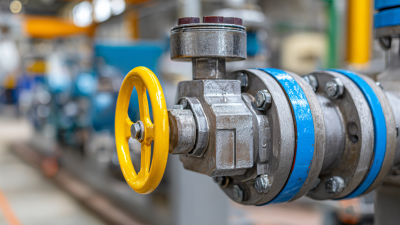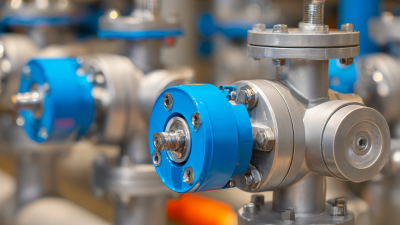
Selecting the right ball valves is crucial for achieving optimal flow efficiency in industrial applications. With an array of options available in the market, understanding the specific requirements of your system is essential to ensure seamless operation. Ball valves, known for their reliability and durability, play a pivotal role in various sectors, including oil and gas, water treatment, and chemical processing. This blog will guide you through a systematic approach to choosing the best ball valves tailored to your operational needs, considering factors such as material compatibility, pressure ratings, and flow characteristics. By making informed decisions, you can enhance system performance, minimize maintenance costs, and maintain safety standards in your industrial processes.

Join us as we explore the integral aspects of ball valve selection to maximize flow efficiency in your facility.
When selecting ball valves for industrial applications, several key factors must be taken into account to ensure optimal flow efficiency. First and foremost, it's essential to consider the valve's size and compatibility with the existing piping system. A valve that is too small may restrict flow, while one that is too large can lead to inefficiencies and increased costs. Therefore, careful measurement and understanding of the system's requirements are critical.
Another important factor is the material of the ball valve. Valves can be made from various materials, including stainless steel, brass, and plastic, each offering unique advantages in terms of durability, corrosion resistance, and weight. The right material depends on the media being handled, temperature, and pressure conditions. Additionally, it is vital to assess the valve's end connection types, as they should align with those used in the piping system to facilitate seamless installation and operation. By focusing on these key aspects, industries can ensure they choose the most efficient ball valves for their specific needs.
When selecting ball valves for industrial applications, it's essential to understand the distinct flow characteristics associated with different types of valves. The two primary types of ball valves are full-port and reduced-port valves.
 Full-port ball valves allow for a smooth flow path with minimal pressure drop, making them ideal for applications requiring maximum efficiency. They are particularly beneficial in situations where the fluid's viscosity or temperature might change, as they maintain a consistent flow rate.
Full-port ball valves allow for a smooth flow path with minimal pressure drop, making them ideal for applications requiring maximum efficiency. They are particularly beneficial in situations where the fluid's viscosity or temperature might change, as they maintain a consistent flow rate.
On the other hand, reduced-port ball valves feature an internal diameter smaller than the pipe, which can lead to a greater velocity of the fluid passing through. While they may cause additional pressure loss, these valves can be more cost-effective and are suitable for applications where flow rates are not critically high. Additionally, variations such as trunnion-mounted and floating ball valves cater to specific operational needs. Understanding these differences enables engineers to make informed choices to optimize flow efficiency and ensure the reliability of their systems.
When selecting the right ball valve for industrial applications, material selection is crucial for ensuring optimal flow efficiency and longevity. The choice of valve material can directly impact the valve's resistance to corrosion, pressure fluctuations, and temperature extremes, making it vital to align material properties with operational conditions. According to a report by the Global Valve Industry Market Research, approximately 50% of valve failures in industrial settings can be traced back to improper material selection.
Common materials for ball valves include stainless steel, carbon steel, and plastic composites. Stainless steel, particularly 316 grade, is widely regarded for its excellent corrosion resistance and ability to withstand high temperatures, making it ideal for applications involving harsh chemicals or high-pressure systems. In contrast, carbon steel valves are often chosen for their strength and cost-effectiveness in less corrosive environments. For applications such as food processing or pharmaceuticals, plastic valves made from materials like PVC or PVDF provide the necessary resistance to chemicals without compromising on hygiene standards. A study by the Valve Manufacturers Association indicates that choosing the right valve material can improve overall system performance by up to 30%, demonstrating the importance of informed material selection.
When choosing ball valves for industrial applications, sizing is crucial to ensure optimal flow efficiency. Properly sized ball valves can significantly influence the performance of a system by minimizing pressure drops and ensuring smooth flow. A common mistake is selecting a valve size based solely on pipeline diameter without considering the specific flow requirements of the application.
**Tip 1:** Always calculate the required flow rate for your system before selecting a valve size. This involves assessing the maximum and minimum flow needs during operation, accounting for factors such as temperature, pressure, and the type of fluid being handled. If you know the desired flow rate, you can match it with the valve's flow coefficient (Cv) to choose the right size effectively.
**Tip 2:** Consider the installation space and the potential for future changes in flow requirements. It might be tempting to go for a standard valve size, but opting for a slightly larger valve can provide flexibility for future adjustments, reducing the need for costly replacements or upgrades. Additionally, make sure to review the manufacturer's specifications and data to ensure compatibility with your system's conditions.
Selecting the right ball valve size is not only about immediate functionality but also about long-term efficiency and adaptability in your industrial applications.
Maintaining ball valves in optimal working condition is crucial for ensuring flow efficiency in industrial applications. Regular inspections should be a part of any maintenance routine. Technicians should look for signs of wear, corrosion, or damage, as these factors can significantly affect performance. Additionally, operators should ensure that the seals and packing are in good shape, as leaks not only reduce efficiency but can also lead to more costly repairs if left unaddressed.
Another essential tip is to clean the ball valve regularly. Accumulation of dirt, debris, or chemical residues can hinder the smooth operation of the valve, so using appropriate cleaning agents based on the specific application is advisable. Proper lubrication is also vital; using the right type of lubricant helps to reduce friction and allows for better movement of the valve. Furthermore, keeping the valve in a controlled environment, where temperature and pressure are monitored, can enhance longevity and reliability, making it easier to maintain optimal flow efficiency in various industrial processes.






